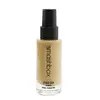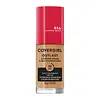Smashbox Studio Skin 24 Hour Hydra Foundation Versus Covergirl Outlast Extreme Wear 3-In-1 Foundation
What's inside
What's inside
 Key Ingredients
Key Ingredients

 Benefits
Benefits

 Concerns
Concerns

 Ingredients Side-by-side
Ingredients Side-by-side

Water
Skin ConditioningCyclopentasiloxane
EmollientTrimethylsiloxysilicate
EmollientTitanium Dioxide
Cosmetic ColorantButylene Glycol
HumectantTrimethyl Pentaphenyl Trisiloxane
EmollientSilica
AbrasivePhenyl Trimethicone
Skin ConditioningMagnesium Sulfate
Polyglyceryl-3 Diisostearate
EmulsifyingTribehenin
EmollientPEG-10 Dimethicone
Skin ConditioningBis-PEG/PPG-14/14 Dimethicone
EmollientTocopheryl Acetate
AntioxidantSodium Hyaluronate
HumectantGlycerin
HumectantEthylhexylglycerin
Skin ConditioningPolyglyceryl-4 Isostearate
EmulsifyingCetyl PEG/PPG-10/1 Dimethicone
EmulsifyingMethicone
EmollientTetramethyl Hexaphenyl Tetrasiloxane
Skin ConditioningPhenyl Methicone
EmollientDimethicone
EmollientLaureth-7
EmulsifyingPolymethylsilsesquioxane
Hexyl Laurate
EmollientDisteardimonium Hectorite
StabilisingCellulose Gum
Emulsion StabilisingPropylene Carbonate
SolventAlumina
AbrasiveXanthan Gum
EmulsifyingDimethicone Silylate
Sorbic Acid
PreservativePhenoxyethanol
PreservativeChlorphenesin
AntimicrobialIron Oxides
CI 77491
Cosmetic ColorantCI 77492
Cosmetic ColorantCI 77499
Cosmetic ColorantCI 77891
Cosmetic ColorantWater, Cyclopentasiloxane, Trimethylsiloxysilicate, Titanium Dioxide, Butylene Glycol, Trimethyl Pentaphenyl Trisiloxane, Silica, Phenyl Trimethicone, Magnesium Sulfate, Polyglyceryl-3 Diisostearate, Tribehenin, PEG-10 Dimethicone, Bis-PEG/PPG-14/14 Dimethicone, Tocopheryl Acetate, Sodium Hyaluronate, Glycerin, Ethylhexylglycerin, Polyglyceryl-4 Isostearate, Cetyl PEG/PPG-10/1 Dimethicone, Methicone, Tetramethyl Hexaphenyl Tetrasiloxane, Phenyl Methicone, Dimethicone, Laureth-7, Polymethylsilsesquioxane, Hexyl Laurate, Disteardimonium Hectorite, Cellulose Gum, Propylene Carbonate, Alumina, Xanthan Gum, Dimethicone Silylate, Sorbic Acid, Phenoxyethanol, Chlorphenesin, Iron Oxides, CI 77491, CI 77492, CI 77499, CI 77891
Ethylhexyl Methoxycinnamate 3%
UV AbsorberCyclopentasiloxane
EmollientWater
Skin ConditioningTalc
AbrasiveButylene Glycol
HumectantCetyl PEG/PPG-10/1 Dimethicone
EmulsifyingAcrylates Crosspolymer
AbsorbentTrimethylsiloxysilicate
EmollientCetearyl Ethylhexanoate
EmollientDimethicone/Vinyl Dimethicone Crosspolymer
Skin ConditioningMagnesium Sulfate
Bis-PEG/PPG-14/14 Dimethicone
EmollientAmmonium Acrylates Copolymer
Tribehenin
EmollientDisteardimonium Hectorite
StabilisingLaureth-7
EmulsifyingLecithin
EmollientTriethoxycaprylylsilane
Phenoxyethanol
PreservativeTrihydroxystearin
Skin ConditioningChlorphenesin
AntimicrobialPropylene Carbonate
SolventAlcohol Denat.
AntimicrobialDimethiconol
EmollientXanthan Gum
EmulsifyingGlycerin
HumectantDisodium EDTA
Tocopheryl Acetate
AntioxidantDisodium Deceth-6 Sulfosuccinate
CleansingLaureth-30
CleansingSodium PCA
HumectantUrea
BufferingSodium Dehydroacetate
PreservativeTrehalose
HumectantHexylene Glycol
EmulsifyingPolyquaternium-51
Skin ConditioningBHT
AntioxidantCaprylyl Glycol
EmollientTriacetin
AntimicrobialSodium Hyaluronate
HumectantPentaerythrityl Tetra-Di-T-Butyl Hydroxyhydrocinnamate
AntioxidantCI 77891
Cosmetic ColorantIron Oxides
Ethylhexyl Methoxycinnamate 3%, Cyclopentasiloxane, Water, Talc, Butylene Glycol, Cetyl PEG/PPG-10/1 Dimethicone, Acrylates Crosspolymer, Trimethylsiloxysilicate, Cetearyl Ethylhexanoate, Dimethicone/Vinyl Dimethicone Crosspolymer, Magnesium Sulfate, Bis-PEG/PPG-14/14 Dimethicone, Ammonium Acrylates Copolymer, Tribehenin, Disteardimonium Hectorite, Laureth-7, Lecithin, Triethoxycaprylylsilane, Phenoxyethanol, Trihydroxystearin, Chlorphenesin, Propylene Carbonate, Alcohol Denat., Dimethiconol, Xanthan Gum, Glycerin, Disodium EDTA, Tocopheryl Acetate, Disodium Deceth-6 Sulfosuccinate, Laureth-30, Sodium PCA, Urea, Sodium Dehydroacetate, Trehalose, Hexylene Glycol, Polyquaternium-51, BHT, Caprylyl Glycol, Triacetin, Sodium Hyaluronate, Pentaerythrityl Tetra-Di-T-Butyl Hydroxyhydrocinnamate, CI 77891, Iron Oxides
Ingredients Explained
These ingredients are found in both products.
Ingredients higher up in an ingredient list are typically present in a larger amount.
Bis-PEG/PPG-14/14 Dimethicone is a type of silicone.
Butylene Glycol (or BG) is used within cosmetic products for a few different reasons:
Overall, Butylene Glycol is a safe and well-rounded ingredient that works well with other ingredients.
Though this ingredient works well with most skin types, some people with sensitive skin may experience a reaction such as allergic rashes, closed comedones, or itchiness.
Learn more about Butylene GlycolThis ingredient is a high molecular weight silicone. It has emulsifying and skin conditioning properties.
Chlorphenesin is a synthetic preservative. It helps protect a product against bacteria in order to extend shelf life. In most cases, Chlorphenesin is paired with other preservatives such as phenoxyethanol and caprylyl glycol.
Chlorphenesin is a biocide. This means it is able to help fight the microorganisms on our skin. It is also able to fight odor-releasing bacteria.
Chlorphenesin is soluble in both water and glycerin.
Studies show Chlorphenesin is easily absorbed by our skin. You should speak with a skincare professional if you have concerns about using Chlorphenesin.
Learn more about ChlorphenesinCi 77891 is a white pigment from Titanium dioxide. It is naturally found in minerals such as rutile and ilmenite.
It's main function is to add a white color to cosmetics. It can also be mixed with other colors to create different shades.
Ci 77891 is commonly found in sunscreens due to its ability to block UV rays.
Learn more about CI 77891Cyclopentasiloxane, or D5, is a silicone used to improve texture of products and trap moisture.
D5 is considered lightweight and volatile. Volatile means it evaporates quickly after application. Once evaporated, D5 leaves a thin barrier that helps keep skin hydrated.
It is also an emollient. Emollients help soften the skin and prevent water loss. Silicones create a silky texture in products. D5 helps other ingredients become more spreadable.
Studies show D5 is safe to use in skincare products. We recommend speaking with a skincare professional if you have concerns.
Learn more about CyclopentasiloxaneDisteardimonium Hectorite comes from the clay mineral named hectorite. It is used to add thickness to a product.
It can also help stabilize a product by helping to disperse other ingredients.
Hectorite is a rare, white clay mineral.
Learn more about Disteardimonium HectoriteGlycerin is already naturally found in your skin. It helps moisturize and protect your skin.
A study from 2016 found glycerin to be more effective as a humectant than AHAs and hyaluronic acid.
As a humectant, it helps the skin stay hydrated by pulling moisture to your skin. The low molecular weight of glycerin allows it to pull moisture into the deeper layers of your skin.
Hydrated skin improves your skin barrier; Your skin barrier helps protect against irritants and bacteria.
Glycerin has also been found to have antimicrobial and antiviral properties. Due to these properties, glycerin is often used in wound and burn treatments.
In cosmetics, glycerin is usually derived from plants such as soybean or palm. However, it can also be sourced from animals, such as tallow or animal fat.
This ingredient is organic, colorless, odorless, and non-toxic.
Glycerin is the name for this ingredient in American English. British English uses Glycerol/Glycerine.
Learn more about GlycerinLaureth-7 is created by the ethoxylation of lauryl alcohol using ethylene oxide. Lauryl alcohol is a fatty alcohol with hydrating properties.
This ingredient is an emulsifier and cleansing ingredient. As an emulsifier, it is used to prevent ingredients from separating. It also helps cleanse the skin by gathering dirt, oil, and pollutants to be rinsed away.
Magnesium Sulfate is a salt. More specifically, it is an epsom salt, or the bath salt used to help relieve muscle aches.
Despite having ‘sulfate’ in the name, it isn’t a surfactant or cleansing agent like sodium lauryl sulfate. Unlike those sulfates, magnesium sulfate doesn’t have the same cleansing or foaming properties (it's simply a type of salt).
In cosmetics, Magnesium Sulfate is used to thicken a product or help dilute other solids. It is a non-reactive and non-irritating ingredient.
One study shows magnesium deficiency may lead to inflammation of the skin. Applying magnesium topically may help reduce inflammation.
You can find this ingredient in sea water or mineral deposits.
Learn more about Magnesium SulfatePhenoxyethanol is a preservative that has germicide, antimicrobial, and aromatic properties. Studies show that phenoxyethanol can prevent microbial growth. By itself, it has a scent that is similar to that of a rose.
It's often used in formulations along with Caprylyl Glycol to preserve the shelf life of products.
This ingredient is a solvent. It helps dissolve active ingredients and alter the texture of products.
Propylene Carbonate is commonly used in makeup and with clay, such as montmorillonite or bentonite.
Studies show this ingredient to be safe for cosmetics. When it is undiluted, it can cause skin irritation. (It is always diluted in skincare and makeup). This ingredient is water-soluble.
Propylene Carbonate is created from propylene glycol and carbonic acid.
Learn more about Propylene CarbonateSodium Hyaluronate is hyaluronic acid's salt form. It is commonly derived from the sodium salt of hyaluronic acid.
Like hyaluronic acid, it is great at holding water and acts as a humectant. This makes it a great skin hydrating ingredient.
Sodium Hyaluronate is naturally occurring in our bodies and is mostly found in eye fluid and joints.
These are some other common types of Hyaluronic Acid:
Learn more about Sodium HyaluronateTocopheryl Acetate is AKA Vitamin E. It is an antioxidant and protects your skin from free radicals. Free radicals damage the skin by breaking down collagen.
One study found using Tocopheryl Acetate with Vitamin C decreased the number of sunburned cells.
Tocopheryl Acetate is commonly found in both skincare and dietary supplements.
Learn more about Tocopheryl AcetateTribehenin comes from glycerin and behenic acid.
It is used as an emollient, or moisturizer. Emollients form a thin barrier on skin to prevent moisture from escaping.
This ingredient may not be Malassezia folliculitis, or fungal-acne safe.
Learn more about TribeheninThis silicone is an emollient. Emollients create a thin film on the skin to prevent moisture from escaping.
It is not soluble in water and helps increase water-resistance in products.
According to a manufacturer, it can blend seamlessly with silicone oils, such as Cyclopentasiloxane.
Learn more about TrimethylsiloxysilicateWater. It's the most common cosmetic ingredient of all. You'll usually see it at the top of ingredient lists, meaning that it makes up the largest part of the product.
So why is it so popular? Water most often acts as a solvent - this means that it helps dissolve other ingredients into the formulation.
You'll also recognize water as that liquid we all need to stay alive. If you see this, drink a glass of water. Stay hydrated!
Learn more about WaterXanthan gum is used as a stabilizer and thickener within cosmetic products. It helps give products a sticky, thick feeling - preventing them from being too runny.
On the technical side of things, xanthan gum is a polysaccharide - a combination consisting of multiple sugar molecules bonded together.
Xanthan gum is a pretty common and great ingredient. It is a natural, non-toxic, non-irritating ingredient that is also commonly used in food products.
Learn more about Xanthan GumThis ingredient is a combination of red, black, and yellow iron oxide pigments. This combination of colors is usually found in foundation, because it results in a "skin" color.